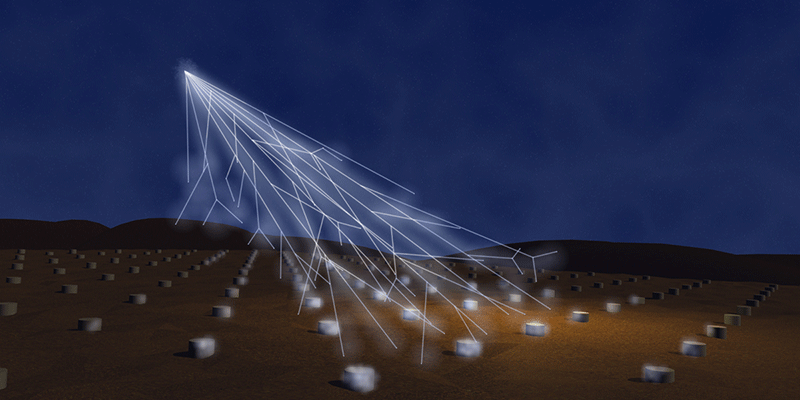Cosmic rays are highly energetic subatomic particles (usually a proton) that travel with speed very close to the speed of light. Their energy range from around 1 GeV (this is the energy of a relatively small particle accelerator) to as much as 108 TeV (way greater than the beam energy of the Large Hadron Collider). When they arrive from the outer space to the Earth’s atmosphere, they interact with the atoms of the atmosphere and they generate huge showers of up to 10 billion secondary particles or more, which can be picked up by particle detectors when they are spread over areas as large as 20 square kilometres on the surface of the Earth (see image).

In their ultrahigh-energy form, cosmic rays have energy levels that exceed one EeV, which is around one million times greater than those reached by the most powerful human-made particle accelerators. Cosmic rays with energies of more than 100 EeV are rarely spotted — fewer than one of these particles arrives on each square kilometre of Earth each century!
Scientists have detected the most powerful cosmic ray seen in more than three decades. But the exact origin of this turbocharged particle from outer space remains a mystery, with some suggesting that it could have been generated by unknown physics. The puzzling cosmic ray had an estimated energy of 240 exa-electronvolts (EeV; 1018 electronvolts), making it comparable to the most powerful cosmic ray ever detected, aptly named the Oh-My-God particle, which measured at around 320 EeV when it was discovered in 1991.
This cosmic particle is named the Sun goddess particle or else “Amaterasu” particle after Amaterasu Ōmikami, the goddess of the sun and the Universe in Japanese mythology, whose name means “shining in heaven.”

The discovery was happened when Toshihiro Fujii, an astronomer at the Osaka Metropolitan University in Japan, stumbled across some bizarre signals on 27 May 2021, while he was doing a routine data check at the Telescope Array, a cosmic-ray detector in Millard County, Utah. The signals suggested that the facilities’ detectors had been smashed with something super energetic, but he was sceptical at first. “I thought there was some sort of mistake or bug in the software,” says Fujii. “I was really surprised.” But measurements were consistent with those produced by ultra-cosmic rays.
The Telescope Array project is a collaboration between universities and institutions in the United States, Japan, Korea, Russia, and Belgium. The experiment is designed to observe air showers induced by cosmic rays with extremely high energy. It does this using a combination of ground array and air-fluorescence techniques. The array of scintillator surface detectors samples the footprint of the air shower when it reaches the Earth’s surface, while the fluorescence telescopes measure the scintillation light generated as the shower passes through the gas of the atmosphere.
